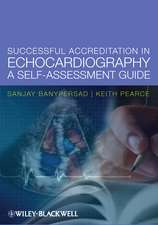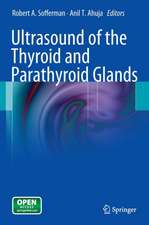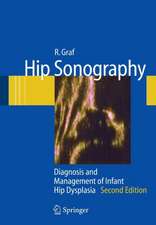Stress Echocardiography
Editat de Eugenio Picanoen Limba Engleză Paperback – 7 oct 2015
| Toate formatele și edițiile | Preț | Express |
|---|---|---|
| Paperback (2) | 1119.50 lei 38-44 zile | |
| Springer International Publishing – 7 oct 2015 | 1119.50 lei 38-44 zile | |
| Springer Berlin, Heidelberg – 13 dec 2014 | 1421.90 lei 43-57 zile | |
| Hardback (1) | 1455.20 lei 38-44 zile | |
| Springer International Publishing – 20 oct 2023 | 1455.20 lei 38-44 zile |
Preț: 1119.50 lei
Preț vechi: 1178.42 lei
-5% Nou
Puncte Express: 1679
Preț estimativ în valută:
214.27€ • 220.82$ • 180.90£
214.27€ • 220.82$ • 180.90£
Carte tipărită la comandă
Livrare economică 26 februarie-04 martie
Preluare comenzi: 021 569.72.76
Specificații
ISBN-13: 9783319307565
ISBN-10: 3319307568
Pagini: 696
Ilustrații: LXXXVII, 696 p. 367 illus., 206 illus. in color.
Dimensiuni: 155 x 235 mm
Ediția:6th ed. 2015
Editura: Springer International Publishing
Colecția Springer
Locul publicării:Cham, Switzerland
ISBN-10: 3319307568
Pagini: 696
Ilustrații: LXXXVII, 696 p. 367 illus., 206 illus. in color.
Dimensiuni: 155 x 235 mm
Ediția:6th ed. 2015
Editura: Springer International Publishing
Colecția Springer
Locul publicării:Cham, Switzerland
Cuprins
1. Stress echocardiography: a historical perspective.- 2. Anatomical and functional targets of stress testing.- 3. Symptoms and signs of myocardial ischemia.- 4. Rational basis of stress echocardiography.- 5. Pathogenetic mechanisms of stress.- 6. Echocardiographic signs of ischemia.- 7. Segmentation of the left ventricle.- 8. Right heart stress echocardiography.- 9. Coronary flow reserve.- 10. Stress echocardiography: instructions for use.- 11. Exercise echocardiography.- 12. Dobutamine stress echocardiography.- 13. Dipyridamole stress echocardiography.- 14. Adenosine and Regadenoson stress echocardiography.- 15. Pacing stress echocardiography.- 16. Ergonovine stress echocardiography.- 17. Hyperventilation, handgrip, cold pressor and squatting stress echocardiography.- 18. Grading of ischemic response.- 19. Diagnostic results and indications.- 20. Myocardial viabili.- 21. Diagnostic flowcharts.- 22. Prognosis.- 23. New technologies.- 24. Contrast stressechocardiography.- 25. Diastolic stress echocardiography.- 26. Endothelial function in the stress echo laboratory.- 27. Special subsets of angiographically defined patients.- 28. Special subsets of electrocardiographically defined patients.- 29. Special subsets of clinically defined patients.- 30. Microvascular disease.- 31. Hypertension.- 32. Diabetes.- 33. Stress echocardiography in dilated cardiomyopathy.- 34. Stress echocardiography in hypertrophic cardiomyopathy.- 35. Stress echocardiography after cardiac transplantation.- 36. Stress Doppler echocardiography in valvular heart disease.- 37. Pediatric Stress echocardiography.- 38. Stress echocardiography and nuclear imaging.- 39. Stress echo vs MSCT.- 40. Stress echo vs cardiac magnetic resonance imaging.- 41. Appropriateness in the cardiac imaging and stress echo laboratory.
Textul de pe ultima copertă
The sixth edition is enriched by over 300 figures, 150 tables and a video-companion collecting more than 100 cases also presented in the format of short movies and teaching cartoons.This extensively revised and enlarged edition of this long-seller (first edition 1991) documents the very significant advances made since the fifth (2009) edition and is entirely written by Eugenio Picano, a pioneer in the field sharing his lifetime experience with the help of an international panel of 50 contributors from 22 countries representing some of the best available knowledge and expertise in their respective field. For a long time, the scope and application of stress echo remained focused on coronary artery disease. In the last years, it has exploded in its breadth and variety of applications. From a black-and-white, one-fits-all approach (wall motion by 2D-echo in the patient with known or suspected coronary artery disease) now we have moved on to a omnivorous, next-generationlaboratory employing a variety of technologies (from M-Mode to 2D and pulsed, continuous, color and tissue Doppler, to lung ultrasound and real time 3D echo, 2D speckle tracking and myocardial contrast echo) on patients covering the entire spectrum of severity (from elite athletes to patients with end-stage heart failure) and ages (from children with congenital heart disease to the elderly with low-flow, low-gradient aortic stenosis).
Caracteristici
This sixth edition of a widely-praised and successful book discusses in detail all aspects of stress echocardiography Explains both mainstream and emerging applications and provides systematic comparisons with competing and complementary cardiac imaging techniques Written by the distinguished pioneer, Eugenio Picano and other contributors selected for their expertise The extra-material in video companion collects more than 100 stress echo cases, 5 short movies, 20 teaching animations and 11 selected slide presentations All video and text material has been collected with the help of 50 coauthors from 22 countries
Recenzii
From reviews of the previous editions:
"Dr. Picano, one of the pioneers of stress echo, describes the pathophysiological basis of the technique extremely well. In addition, both the advantages and the limitations of the method are covered in a clear and comprehensive way. The book will be useful to cardiologists and even 'non-experts' such as echo technicians and students" (CARDIOVASCULAR RESEARCH)
"A narrative and enjoyable styleà An extremely valuable and important book for those who practice stress echo and are interested in clinical and scientific aspects of the method." (DER INTERNIST)
From the reviews of the fourth edition:
"The book is written for physicians and sonographers practising stress echocardiography and for beginners … . The book provides an up-to-date, extensive and comprehensive coverage of various means of performing stress echocardiography, the implications that each suggest with diagnostic flow charts, the new technological developments with their applications …. . At present it is the only existing book covering all aspects of stress echocardiography. This book is a pleasure to read and reflects the tremendous contribution of dr. Picano in this field." (Bharati Shivalkar, Acta Cardiologica, Vol. 59 (4), 2004)
"Dr. Picano, one of the pioneers of stress echo, describes the pathophysiological basis of the technique extremely well. In addition, both the advantages and the limitations of the method are covered in a clear and comprehensive way. The book will be useful to cardiologists and even 'non-experts' such as echo technicians and students" (CARDIOVASCULAR RESEARCH)
"A narrative and enjoyable styleà An extremely valuable and important book for those who practice stress echo and are interested in clinical and scientific aspects of the method." (DER INTERNIST)
From the reviews of the fourth edition:
"The book is written for physicians and sonographers practising stress echocardiography and for beginners … . The book provides an up-to-date, extensive and comprehensive coverage of various means of performing stress echocardiography, the implications that each suggest with diagnostic flow charts, the new technological developments with their applications …. . At present it is the only existing book covering all aspects of stress echocardiography. This book is a pleasure to read and reflects the tremendous contribution of dr. Picano in this field." (Bharati Shivalkar, Acta Cardiologica, Vol. 59 (4), 2004)
Notă biografică
Eugenio Picano, MD, PhD, obtained his Degree in medicine in 1981, to which a Cardiology fellowship, and a PhD in Cardiovascular Pathophysiology in Pisa University followed. Research Director in the Biomedicine Department of the National Research Council until June 2023. A clinical cardiologist with a strong background in cardiovascular imaging and multidisciplinary research, he has published 520 papers in peer-reviewed journals (h-index= 98 by Google Scholar as per January 30, 2023). He is recognized for contributions in stress echocardiography, medical radiation effects on doctors and patients, extravascular lung water detection by lung ultrasound and non-invasive biopsy of atherosclerotic plaque by tissue characterization techniques.











